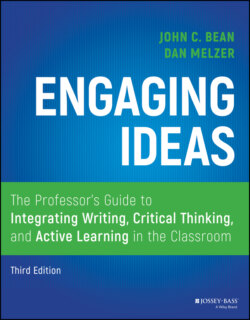Читать книгу Engaging Ideas - John C. Bean - Страница 48
2 How Writing Is Related to Critical Thinking
ОглавлениеThe Writing Across the Curriculum movement—along with a surge of new interest in composition theory and practice—began in the 1970s as a reaction against traditional writing instruction that associated good writing primarily with grammatical correctness and style and thus isolated writing instruction within English departments, the home of the grammar and style experts. The problem with traditional writing instruction was that it led to a view of writing as a set of isolated skills unconnected to an authentic desire to converse with interested readers about real ideas.
A classic Shoe cartoon from the late 1980s illustrates the traditional view. Skyler, a bright young bird of a student, sits at his school desk writing essays—an activity that he apparently relishes. “They give me an opportunity to perfect a verbal skill I can use all my life,” he says with a self‐satisfied smile. In the last frame of the cartoon, his smile turns to a triumphant grin as he discloses the skill he has in mind: “the ability to disguise total ignorance with good writing.”
To the general public this is a funny cartoon; to us it symbolizes what was wrong with traditional writing instruction. Skyler believes that the act of writing can be separated from thinking, that writing is merely packaging and thus a separate thing from “content,” which he assumes exists independently, apart from language. To put it another way, writing is like the box and wrapping paper into which we put our already formulated ideas. Once writing is imagined as “packaging,” students find little use for it. Separated from the act of thinking and creating, writing becomes merely a skill that can be learned through grammar drills and through the production of pointless essays that students do not want to write and that teachers do not want to read. This is the view of writing held by many first‐year students when they show up at our doors to begin their college careers. It is the challenge of faculty across the disciplines—along with their colleagues in writing programs and writing centers—to show them other ways of imagining writing.
To gain a different perspective on writing, let's see what writing looks like through the metaphors of a different language. In French, the word for a rough draft is brouillon, derived from a verb meaning “to place in disorder, to scramble.” This metaphor suggests a writing process that begins as a journey into disorder, a making of chaos, out of which one eventually forges an essay. Perhaps driven by their awareness of disorder in the term brouillon, the French place an equally strong emphasis on a plan (roughly equivalent to the English outline), which is the principle of order that the mind must impose on the scrambled brouillon. Together the metaphors plan and brouillon reveal a creative tension between order and disorder. In English, we have no equivalent word for a brouillon. Our phrase “rough draft” suggests something that must be smoothed and polished, but not something deliberately scrambled, something placed in disorder, something that must be wrestled into form. Nor is our word outline—suggesting an inert structure—exactly equivalent to plan, which like the English word plan implies a sense of human purpose and intention.
Viewed in the light of the metaphorical brouillon and plan, traditional writing instruction seems impoverished indeed. Traditionally, we have seldom suggested to students that writing has a brouillon stage, a creative period of confusion and disorder; rather, we have taught that writing begins with an outline. Without the brouillon, we have eliminated from our writing classes the rich, creative source of ideas and substituted instead a sterile order that leaves us obsessed with correctness, neatness, and propriety. The message from our schools has often been that writing is a joyless activity, an opportunity mainly for displaying errors for teachers to red‐pencil. The social cost is incalculable: when writing gets separated from what the writer really thinks, the experience of “really thinking” can be quickly lost from the curriculum.
The writing‐across‐the‐curriculum movement is thus rooted in a radical re‐envisioning of what it means to be a writer. It is the purpose of the two chapters in part 1 to sketch for the reader a general overview of the theory, principles, and rationale that underlie a revised approach to writing, one that can accelerate students' growth as thinkers and learners. This chapter discusses how writing can be best understood as a process of critical thinking. Chapter 3 connects critical thinking to rhetorical thinking—helping students address rhetorical problems of audience, purpose, and genre and appreciate how academic disciplines create their own discourse communities. Together, these chapters provide the underlying theory for the rest of the book's pragmatic focus on classroom strategies for improving students' writing and critical thinking.
